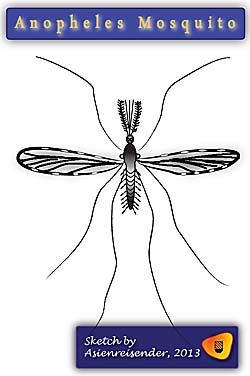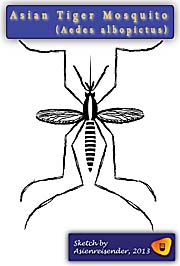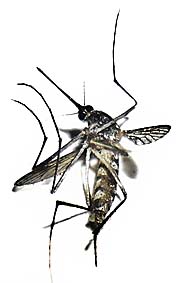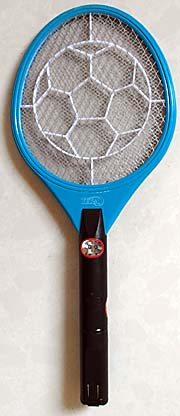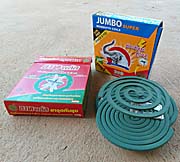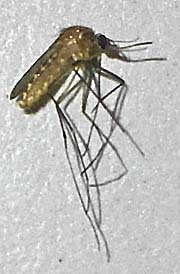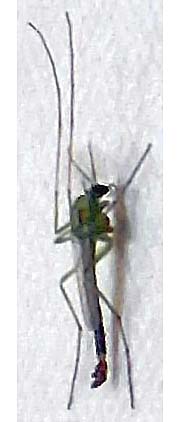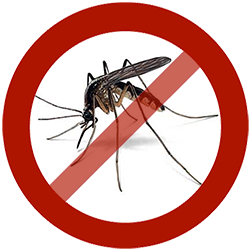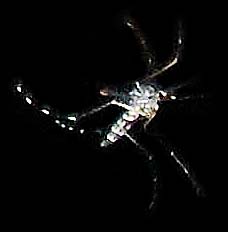The oldest known mosquito remain discovered until now is some 79 million years old. It's imbedded into a piece of amber.
Although generally very small animals, some of them reach a size of more than 15mm.
The number of different kinds of mosquitoes in total vary between 2,500 and 3,500 species, they appear worldwide except in the polar regions and in deserts. They breed at waterplaces of all kind. In the swamps of Siberia, Canada and the north of Europe they appear in the summer month in masses and are much bigger and their bites leave a much bigger impact on the skin than the ones in Southeast Asia. Therefore they are much less dangerous in the north than in the tropical regions of the globe. Particularly the anopheles (malaria) mosquito is a very small representative of his kind. When sitting on walls or the skin it's body shows a peculiar angle of some 45 degree to where it sits on, what makes it distinctive from other mosquito types.
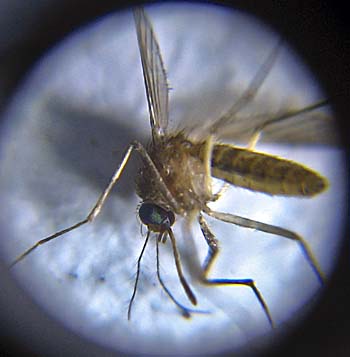
A mosquito, caught during the rainy season in north Thailand. The rostrum is well to see. Seems to be a male. The females are the dangerous ones, for only they are blood suckers. Image by Asienreisender, 2011
Mosquitoes do not feed from blood, but from nectar and fruit juices. Only the females suck additionally blood. They need the containing proteins for their eggs. A 'blood meal' of a female mosquito is sufficient for around 100 eggs, who are layed two to three days after it. In their lifespan, which lasts several weeks, a female mosquito can produce 1,000 or more eggs in her life. Though, there are also kinds of mosquitoes who don't bite humans but exclusively animals, and a few others who don't bite at all.
They lay their eggs one by one on the surface of calm, preferable clear water. The development from egg via larva and pupa to a flying mosquito takes about two weeks.
Their rostrums contain two canals. One is injecting a protein containing saliva for a first, external digesting or preparation of the blood, through the other canal the mosquito sucks it's meal up. The injected protein leads to a small allergic reaction and the well-known itching swelling. If the bite hits directly a nerve, the bit can trigger a small pain. It's, by the way, said that the bite of a female anopheles (malaria) mosquito is particularly itchy.
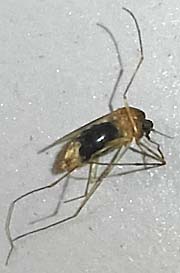
A mosquito after a blood meal. Image by Asienreisender, 2013
Everybody made already the experience, that some people attract mosquitoes more than others do. That has to do with the human smell, which attracts the animals. The smell of lactic acid and other substances on the skin and in sweat serves for their orientation. When they are already close to humans, they also orientate visually and on body temperature.
That explains an observation frequently done while hiking in the jungle. Jungle trekking is a sweat-driving activity. Soon many mosquitoes are attracted and buzz around one's head.
Male mosquitoes are in average 20% smaller than females, and they have bushy tentacles. As already mentioned males are not able to bite.
Most active mosquitoes get at warm, calm days without direct sunlight. When it gets too windy, they can not navigate anymore. That's why they have problems with ventilators. When it's too cool (10 degree or less) they get numb and paralized. They particularly dislike air conditioners.
Mosquitoes can fly over distances of several kilometers. Their speed can be considerable; it's sometimes remarkable how quick they can disappear when being hunted. They manage to fly closely along walls, tree stams etc. to get cover and their trajectory is often very twisting and unpredictable. If the wind is favourable mosquitoes can fly as high as a hundred meters.
Mosquitoes are generally most active in the evening around sunset, sometimes in the morning, but can additionally appear at all times at day and night. Malaria mosquitoes are night active, while the ones transferring dengue are day active.
A Historical Witness
The famous explorer Henri Mouhot described in his travel journals repeatedly how much he had to suffer under the mosquito plague. Nowadays, after many of the swamps and marshlands are cultivated and the tropical rainforests are mostly disappeared, it's barely imaginable how troublesome the little bloodsuckers must have been in former centuries. They appeared sometimes in swarms, darkening the sun; at day and night they attacked. Repellents weren't invented, so that the people had to rely on clothing and burning fires to keep the mosquitoes on distance.
Mouhot himself didn't know that mosquitoes cause the notorious 'jungle-fever', how he called malaria. After more than three years travelling he fell victim to malaria and died in the deep jungles of Laos, not far from Luang Prabang.
 During my stay here [in Petchaburi] it has rained continually, and I have had to wage war with savage foes, from whom I never before suffered so much. Nothing avails against them; they let themselves be massacred, with a courage worthy of nobler beings. I speak of mosquitoes. Thousands of these cruel insects suck our blood night and day. My body, face, and hands are covered with wounds and blisters. I would rather have to deal with the wild beasts of the forest.
During my stay here [in Petchaburi] it has rained continually, and I have had to wage war with savage foes, from whom I never before suffered so much. Nothing avails against them; they let themselves be massacred, with a courage worthy of nobler beings. I speak of mosquitoes. Thousands of these cruel insects suck our blood night and day. My body, face, and hands are covered with wounds and blisters. I would rather have to deal with the wild beasts of the forest.
At times I howl with pain and exasperation. No one can imagine the frightful plague of these little demons, to whom Dante has omitted to assign a place in his infernal regions. I scarcely dare to bathe, for my body is covered before I can get into the water."
Mouhot, Henri:
Travels in the central parts of Indochina,
London 1864
Volume II, p. 57
